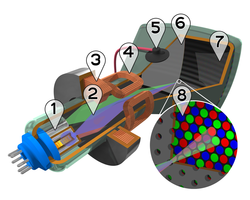Physical Changes:
The first expiroment with a CD was to place pressure on it, by putting it under a heavy chiffonier. This showed that the CD was unaffected by the weight.
Under the chiffonier:
The Second experiment involved a sharp object (compass needle), and a CD. This was to test its durability against a sharp objec and what would happen if similar pressure like before was place on it but instead with a sharp object. The sharp object created scratches on the CD.
Scratched by compass needle:
The third experiment dealt with a lazer and a CD. The laser I used was my computers, it is the same kind that is used to burn data on to CDs. The laser's heat produced images on the CD. I was able to burn my name onto the CD using a program called "LabelPrint".
Effect of the laser on the CD:
For the fourth experiment I broke the CD to test how durable it could be. I applied veritcal force on the CD and it broke into several pieces.
Broken CD:
The fifth and last physical property I found was, what happens when I freeze a CD. The CD was placed in the freezer to see if anything would happen. Physicaly and chemically it was unchanged. The CD did not show any change from before it was placed untill it was taken out.
CD after being frozen: (right one)











